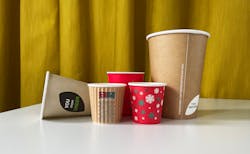Bring a Mug and Ditch Your Straws: The Paradox of Paper
The seemingly virtuous move to chug your coffee from a paper cup — or sip your soda through a paper straw — might not be good for the environment, after all.
Research carried out at the University of Gothenburg, Sweden, shows that discarded paper cups can harm living organisms, while research at the University of Antwerp, Belgium, suggests that using paper straws may have no environmental benefits.
The Swedish research, led by Bethanie Carney Almroth, professor of Environmental Science at the Department of Biology and Environmental Science at the university, compared the potential toxicity of traditional plastic cups and lids with paper cups.
The researchers performed leaching experiments under several different conditions and tested both acute and chronic toxicities in Chironomus riparius midges. These ecologically important aquatic invertebrates are a model species commonly used in toxicity testing.
“We left paper cups and plastic cups in wet sediment and water for a few weeks and followed how the leached chemicals affected the larvae. All the mugs negatively affected their growth,” Almroth explained.
The effects were observed after one week of material leaching in environmental conditions and tended to increase with increasing leaching time.
The point is that raw paper is neither fat- nor water-resistant. The reason the coffee doesn’t soak your hand is that the paper holding it is lined with a thin surface coating of plastic — typically polylactide (PLA).
Produced from corn, cassava or sugarcane, PLA is regarded as biodegradable. While this may be the case, the Gothenburg researchers show that it can still be toxic.
“Bioplastics do not break down effectively when they end up in the environment, in water. There may be a risk that the plastic remains in nature and resulting microplastics can be ingested by animals and humans, just as other plastics do. Bioplastics contain at least as many chemicals as conventional plastic,” added Almroth.
Reporting their results in a recent issue of Environmental Pollution, Almroth and her colleagues say that major shifts are needed to mitigate the continuing damage to the environment and health caused by plastic pollution.
“When disposable products arrived on the market after the Second World War, large campaigns were conducted to teach people to throw the products away, it was unnatural to us! Now we need to shift back and move away from disposable lifestyles. It is better if you bring your own mug when buying takeaway coffee. Or, take a few minutes, sit down and drink your coffee from a porcelain mug,” she said.
Meanwhile, the Antwerp researchers found poly- and perfluoroalkyl substances (PFAS) in 18 out of 20 brands of paper straws tested.
In what they say is the first analysis of its kind in Europe, the team purchased 39 different brands of drinking straws made from five materials: paper, bamboo, glass, stainless steel and plastic. Each underwent two rounds of testing for PFAS using a combination of both targeted and suspect screening approaches.
Paper straws were most likely to contain PFAS, with the chemicals detected in 18 of the 20 brands tested. They were also detected in four of the five brands of bamboo straw, three of the four plastic straw brands and two of the five brands of glass straws tested. PFAS were not detected in any of the five types of steel straws tested, notes a study published in a recent Food Additives and Contaminants.
Also detected were trifluoroacetic acid (TFA) and trifluoromethanesulfonic acid (TFMS), known as the “ultra-short chain” PFAS, which are highly water-soluble and so might leach out of straws into drinks.
As concentrations found were low, and bearing in mind most people use straws only occasionally, the threat to human health was considered limited.
However, Thimo Groffen, an environmental scientist at the University of Antwerp who was involved in the study issued this caution: “Small amounts of PFAS, while not harmful in themselves, can add to the chemical load already present in the body.”
What the study didn’t investigate was whether the PFAS were added to the straws by manufacturers for waterproofing, or whether they were the result of contamination. Such contamination, say the researchers, could come from the soil in which the plant-based materials were grown, and the water used in the manufacturing process.
Nevertheless, they speculate that the presence of the chemicals in almost every brand of paper straws means it is likely that it was, at least in some cases, being used as a water-repellent coating.
The study’s other limitations included not looking at whether the PFAS would leach out of the straws into liquids, they add.
“The presence of PFAS in paper and bamboo straws shows they are not necessarily biodegradable,” said Groffen, adding that the best solution would be either to use stainless steel options, or avoid straws altogether.
